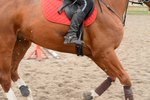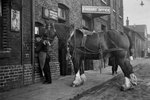
Both a calf rope and a head rope are used as part of roping activities either on ranches or in rodeo events. The main difference between these two types of ropes is how they are used in these activities. A calf rope typically is used in tie-down roping while a rope is generally part of the equipment for team roping.
Rodeo Background
Today, rodeos are spectator events where individuals compete to demonstrate their roping, branding and sorting abilities. However, these events grew out of real skills ranchers needed to manage their cattle in the Old West. The term "rodeo" actually means roundup and most of the activities in these events would have been used to collect cattle into herds to move them back into their quarters at the ranch. Although associated with American cowboys, much of the activities associated with rodeos can be traced back to roots in Mexico and Spain. However, the rodeo as an event became popularized in the United States by Buffalo Bill in the late 1800s.
Tie-Down Roping
Calf rope is typically used during a rodeo event known as tie-down roping. During this event, the goal for the participant is to immobilize the calf using rope in a procedure once used by ranchers when they needed to treat a sick or injured calf. In the rodeo event, the calf does receive a head start in the ring. The participant, usually referred to as a cowboy, rides a horse after the calf and attempts to put a rope around its neck. When this is accomplished, the rider dismounts his horse and ties three of the calves' legs together using pigging string. Calf rope is typically used to catch the calf around the neck.
Team Roping
Head rope is usually used in the rodeo event called team roping. The goal of this event is for two cowboys to immobilize a steer using ropes. The event stems from ranch activities in which large steers often needed to be captured for branding or other purposes. Because of the steer’s size and strength, more than one person was needed for the job. In the spectator event, the first cowboy (called the header) uses rope to capture the head of the steer either by roping both horns, the neck, or one horn and the head. Then, the other cowboy (called the heeler) must rope the steer’s hind legs. The head rope is used by the header while a different rope is used by the heeler.
Other Calf Rope Uses
In addition to its use in tie-down roping, calf rope is also a slang term that someone might use when they want to give up. The term's use dates back to at least 1878 when it referred to a gesture of surrender the loser was required to make when he had been beaten. Although most common in the southern states, the use of "calf rope" is comparable to the use of "uncle" to signify when a person has had enough and wants to give up.
References
Photo Credits
-
Jupiterimages/Photos.com/Getty Images
Writer Bio
Amy Jorgensen has ghostwritten more than 100 articles and books on raising and training animals. She is also an amateur dog trainer. She has also written more than 200 blog posts, articles, and ebooks on wedding and party planning on behalf of professionals in the field.



